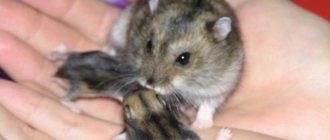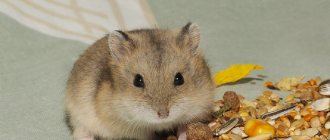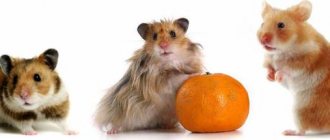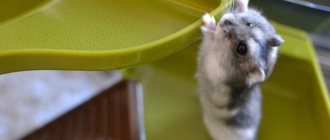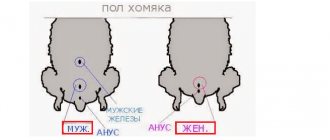The smallest rodent of the Hairy-footed species is considered to be the Roborovsky hamster. The discoverer of the dwarf animal is the Russian scientist V.I. Roborovsky. The hamster was discovered in the 19th century in the foothills of the Tien Shan. Wild habitat in nature is limited to China and Mongolia. In the 20th century, the hamster was exported to the countries of the Soviet Union. The Roborovsky hamster is called the Russian dwarf winter white hamster. “Russian” - because it was Russian scientists who made a great contribution to the study of this species, and “winter white” - because of the rodent’s ability to change the color of its coat in winter.
Appearance
He is often confused with Dzungarik. In fact, there is a significant difference between the brothers. Hamsters of the Roborovsky breed grow no more than 6 cm in length. The weight of an adult hamster is 25 grams. There are also serious differences in appearance: a small, seemingly flattened muzzle; black eyes; the ears are gray, round in shape, and seem huge compared to the body; the coat is longer than that of other individuals of this species; the tail is not noticeable at all; has 4 toes on the front paws and 5 toes on the hind paws; has excellent vision; A characteristic feature of the species is the white eyebrows above the eyes. The coat color is brown or sand with a golden tint. The abdomen and paws are milky in color.
Temperament
The character of hamsters of this species is distinguished by great individuality. The following features stand out:
- Cowardice. By nature, the Roborovsky hamster is timid. Cannot stand screaming, loud conversation, or the sight of other pets. At the slightest noise he faints. Capable of getting sick or dying from extreme stress.
- Mobility. It is very active, so it is better not to pick it up, there is a high probability that it will slip out and break.
- Sociability. Animals can be kept in pairs or groups. Only these must be same-sex hamsters from the same litter. If you put adults in the same cage, there will be constant fights for territory. You should also not add a “stranger” to an already formed group; he will be offended.
- Caution. It will be more difficult to tame a rodent than other dwarf hamsters. This is also due to their character.
- Not vindictive. Hamsters have a good-natured disposition and practically do not bite. If this happens, small teeth are not able to bite through human skin.
- Cleanliness. They love to take care of themselves, constantly washing their hind legs and combing their fur. They never have an unpleasant odor.
Roborovsky's hamster is considered a cute and cuddly creature. He is most popular among his brethren of the Hairfoot clan. Therefore, its price is higher than other rodents. You should buy a hamster for school-age children. For kids, opt for larger breeds of hamsters.
Roborovsky's hamster: what it looks like, what to feed, how to care for it
In nature, there are about 20 species of hamsters, which are divided into 6 genera. And only a few of them are popular in home breeding. They differ in color, size and lifestyle. The smallest and rarest among domestic fluffies is the Roborovsky hamster. It is no larger than a chicken egg, which is why it is called dwarf. This baby is better suited than some other hamsters to be a pet. On the other hand, caring for it, although simple, has some peculiarities.
Features of home maintenance
The animal is too small to purchase a cage for, so opt for an aquarium or container. The size of the home is chosen based on how many hamsters you will keep. For one, a size of 50*50 cm is enough, for two, 70*70 cm. Buy a running wheel and a house; you can make labyrinths yourself from cardboard. The rodent needs to give free rein to its energy; a sedentary lifestyle causes stress. How long hamsters live depends on the quality of home care. With proper maintenance, life expectancy is three years.
Instead of sawdust, you can put sand purchased at a pet store at the bottom of the container. Outdoor food is not suitable, as it may contain microbes, worm eggs and other microorganisms that are harmful to the health of the animal. Buy a toilet tray and filler there. The sand is changed once a week, the contents of the tray are removed as needed.
Additionally, buy a bowl and a special drinking bowl.
Possible troubles
The life of robos is short (no more than 2 years) and fleeting. Increased metabolism also contributes to the rapid development of the disease. If there is a suspicion of its occurrence, then immediately contact a specialist. It is advisable to find out in advance who exactly knows how to treat hamsters.
Dwarfs often have fractures, which is associated with their activity or improper organization of space. Usually the bones heal quickly, but during the recovery period the wheel and other attractions are removed and the baby is provided with peace.
Do hamsters hibernate? Often, owners observe a picture when their pet does not move and seems to have died. Most likely, the hamster is numb from the cold. It will be enough to warm it in your palms and warm the room to a temperature of 21 ° C for the pet to come to life again and run around happily.°
Nutrition
How long hamsters live depends on what they eat. Their diet should consist of store-bought food. Do not skimp when choosing a feed mixture; often a cheap mixture contains poorly processed, dusty grains and seeds.
The following products are also allowed:
- Fruits and berries: pears, apples, apricots, raspberries, currants, dried fruits. This is given as a treat and not often, once or twice a week is enough.
- Vegetables: carrots, pumpkin, zucchini.
- Greenery. Both homemade (parsley, dill) and forest (dandelion, nettle) are suitable.
- Seeds and nuts.
- Protein food. Chicken, fish, cottage cheese.
- "Live" meat. You can buy grasshoppers and worms at the pet store.
List of prohibited products:
- Sausages.
- Bakery products.
- Watermelons and melons.
- Citrus.
You need to feed the animal twice a day, or four times, but in small portions. Products should always be fresh. Check your hamster's supplies regularly and throw away anything that spoils. Poisoning from spoiled food can be fatal.
Reproduction
Hamsters are very fertile: during the season (from May to September) a female can give birth to offspring two to four times. Animals not younger than a month old, but not older than a year, are allowed to breed.
Puberty occurs at 3 weeks, but the female is not physically ready to bear and give birth to a healthy offspring. At a more mature age, physiological old age sets in and the female is also at risk of deteriorating health during pregnancy and problems during childbirth, and, therefore, one cannot expect good hamsters from her.
Pregnancy lasts 19-20 days. The cubs are born blind and naked, but after a week they are completely covered with fur, after a while their eyes open, and by the end of the second week of life they are completely ready for independent existence.
At this point, it is advisable to separate all the babies by gender, otherwise they may begin to mate and reproduce uncontrollably.
If it is planned to sell or give away a new generation for free, then this should be done no earlier than five weeks from birth.
Breeding at home
Pairs need to be formed in infancy. If this was not possible, then the adults should be given time to get used to each other. At the pet store you can purchase a special grid for the cage, which will allow the animals to sniff, but not make contact, this will eliminate conflicts. The grate is removed after eight to ten days.
The duration of pregnancy is 25 days. At this time, you should not disturb the pregnant woman; she may show aggression and bite. Pay special attention to nutrition; your diet should be as varied as possible. Arrange her home properly. Give the opportunity for privacy; for this purpose, install an individual house, or better yet two. Pour some sawdust, and with their help the expectant mother will make a nest for her offspring.
Female Roborovskis are not as fertile as females of other species. The litter does not exceed six cubs. Hamsters are born hairless and blind. After a week of life, their bodies become covered with fluff. They become independent within two weeks. Baby purees and cereals are suitable as complementary foods. It is better to hold off on fruits and herbs so as not to cause loose stools in babies.
How to choose the right one and how much it costs
The choice of a tiny pet must be approached with the utmost seriousness, otherwise you can buy a sick, old male or pregnant female.
What to pay attention to when purchasing:
- age: 1–2 months (if younger, it may die without a mother; if older, it will be difficult to tame);
- housing conditions: clean, odorless, suitable cage;
- behavior: the animal is active, nimble, does not sit still (“watching” is best done in the evening, when hamsters wake up and become more active);
- appearance: the baby is well-fed, the coat is shiny, clean, not disheveled, without bald spots, the eyes are shiny and do not water;
- health: the tummy is elastic, around the anus is dry and clean, there is no discharge from the nose and mouth, the ears are clean, without crusts, breathing is calm, without wheezing.
Although this rodent is smaller than all other pet hamsters, it is more expensive than them. To purchase it from professional breeders, you will need to pay $10–15. The price in the pet store and on the market is much lower. But it is better to take hamsters from a nursery. There the babies are healthy and already accustomed to being handled, and are kept in good conditions. From the breeder you can get information about the chosen one’s parents, his pedigree and qualified advice on his correct maintenance.
Hamster diseases
Rodents of this species are distinguished by good health. No hereditary diseases were identified. There are a number of diseases due to poor nutrition:
- Diarrhea or constipation. They can occur when an animal is overfed with bakery products.
- Hair loss. Baldness occurs due to a lack of vitamins in the diet.
- Obesity. Improper feeding or sedentary lifestyle.
- Damage to the cheek pouches. The animal should not be given boiled porridge, chocolate, sweets, or bones. These products clog and injure the cheek pouches.
Other diseases:
- Bites received in a fight.
- Eye disease. Occurs due to infection in the eyes.
- Fractures and dislocations.
- Gastrointestinal diseases.
It should be remembered that Roborovsky hamsters live in the wild for up to one and a half years; with careful home care, the pet’s life can be extended to three to four years.
Choosing and arranging a home
Living conditions for baby Roborovsky are very important. The smallest cell or glass jar is not an option. In order for him to feel at home, cozy and comfortable, the housing must suit him in size and interior.
Cage or aquarium
Some breeders prefer to keep their small pets in small cages. Others think that an aquarium is more suitable. Both have their advantages and disadvantages. For example, a cage is good because air constantly circulates in it. But its lattice walls are no obstacle for these babies, who can slip through any opening, no matter how narrow it may be. In this regard, an aquarium is more reliable than a cage; not a single hamster can escape from it. However, its glass walls do not allow air to pass through, fog up and are a favorable place for the growth of fungi that are dangerous to health.
This is why many people place their pets in plastic containers with high walls or in special dunes. This is a more suitable option: the nimble will not escape from this housing, and the air moves freely there. The size of this house is important. Even though this hamster is the smallest, he needs a lot of space, as he is very mobile and constantly runs somewhere. The recommended container size for 1–2 individuals is 70x50 cm. With a larger number of residents, a larger living space is needed.
What does a hamster need?
The way the dune is arranged is directly related to the well-being and health of small rodents. In nature, they live in the sands of the Mongolian and Chinese steppes, so they like it when the bottom of the “apartment” is covered with a 3-centimeter layer of fine sand, possibly quartz.
Necessary interior items:
- House: should be quite large to accommodate not only the hamster, but also his food supplies, which he will definitely drag there, here he will hide during stressful situations. If you keep several individuals at once, then each of them needs its own house.
- Running wheel: diameter - 18 cm, the running surface is not lattice, but solid, so that the runner’s paws do not get hurt. The wheel is necessary to maintain physical fitness.
- Toilet: a tray with a special filler that will help keep the cage clean and odorless. Your pet should be accustomed to it from a very young age.
- A feeder, or better yet two: for dry food and for fresh vegetables and fruits.
- Drinking bowl: located next to the feeders, you need to teach the kids to drink from it.
- Mineral stone: needed for grinding down teeth that grow throughout life. It also contains useful substances.
- Tunnelsfor climbing: from plastic pipes or cardboard rolls.


